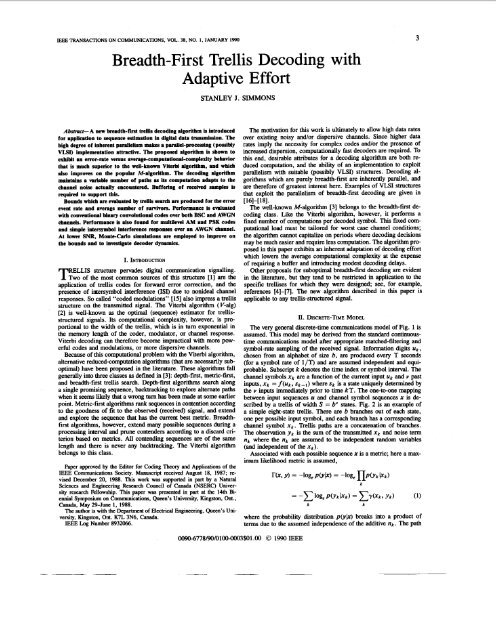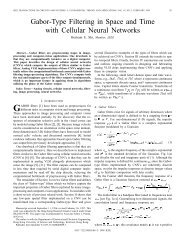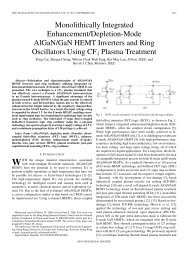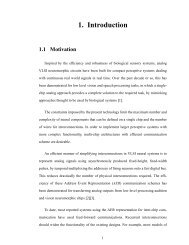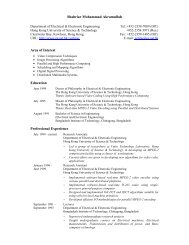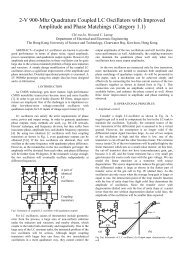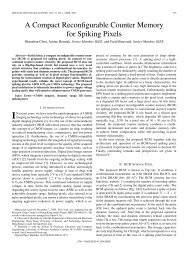Breadth-first trellis decoding with adaptive effort - Department of ...
Breadth-first trellis decoding with adaptive effort - Department of ...
Breadth-first trellis decoding with adaptive effort - Department of ...
You also want an ePaper? Increase the reach of your titles
YUMPU automatically turns print PDFs into web optimized ePapers that Google loves.
IEEE TRANSACTIONS ON COMMUNICATIONS, VOL. 38, NO. 1, JANUARY 1990 3<strong>Breadth</strong>-First Trellis Decoding <strong>with</strong>Adaptive EffortSTANLEY JSIMMONSAbsrmct-A new breadth-fit <strong>trellis</strong> <strong>decoding</strong> algorithm is introducedfor application to sequence estimation in digital data tr’nnsmission. Thehigh degree <strong>of</strong> inherent parallelism makes a pdel-proeessing (possiblyVLSI) implementation attractive. The proposed algorithm is shown toexhibit an error-rate versus average-computatiod-complexity behaviorthat is much superior to the well-known Viterbi algorithm, and whichalso improves on the popular M-algorithm. The <strong>decoding</strong> algorithmmaintains a variable number <strong>of</strong> paths as its computation adapts to thech~nd noise actually encountered. Buffering <strong>of</strong> received samples isrequired to support this.Bounds which are evaluated by <strong>trellis</strong> search are produced for the errorevent rate and average number <strong>of</strong> survivors. Performance is evaluated<strong>with</strong> conventiod binary convolutiod codes over both BSC and AWGNchannels. Performance is also found for multilevel AM and PSK codesand simple intersymbol interference responses over an AWGN ehannel.At lower SNR, Monte-Cad0 simulations are employed to improve onthe bounds and to investigate decoder dynamics.T””I. INTRODUCTIONLIS structure pervades digital communication signalling.Two <strong>of</strong> the most common sources <strong>of</strong> this structure [l] are theapplication <strong>of</strong> <strong>trellis</strong> codes for forward error correction, and thepresence <strong>of</strong> intersymbol interference (ISI) due to nonideal channelresponses. So called “coded modulations” [15] also impress a <strong>trellis</strong>structure on the transmitted signal. The Viterbi algorithm (V-alg)[2] is well-known as the optimal (sequence) estimator for <strong>trellis</strong>structuredsignals. Its computational complexity, however, is proportionalto the width <strong>of</strong> the <strong>trellis</strong>, which is in turn exponential inthe memory length <strong>of</strong> the coder, modulator, or channel response.Viterbi <strong>decoding</strong> can therefore become impractical <strong>with</strong> more powerfulcodes and modulations, or more dispersive channels.Because <strong>of</strong> this computational problem <strong>with</strong> the Viterbi algorithm,alternative reduced-computation algorithms (that are necessarily suboptimal)have been proposed in the literature. These algorithms fallgenerally into three classes as defined in [3]: depth-<strong>first</strong>, metric-<strong>first</strong>,and breadth-<strong>first</strong> <strong>trellis</strong> search. Depth-<strong>first</strong> algorithms search alonga single promising sequence, backtracking to explore alternate pathswhen it seems likely that a wrong turn has been made at some earlierpoint. Metric-<strong>first</strong> algorithms rank sequences in contention accordingto the goodness <strong>of</strong> fit to the observed (received) signal, and extendand explore the sequence that has the current best metric. <strong>Breadth</strong><strong>first</strong>algorithms, however, extend many possible sequences during aprocessing interval and prune contenders according to a discard criterionbased on metrics. All contending sequences are <strong>of</strong> the samelength and there is never any backtracking. The Viterbi algorithmbelongs to this class.Paper approved by the Editor for Coding Theory and Applications <strong>of</strong> theIEEE CommunicatiOns Society. Manuscript received August 18, 1987; revisedDecember 20, 1988. This work was supported in part by a NaturalSciences and Engineering Research Council <strong>of</strong> Canada (NSERC) Universityresearch IWknvship. This paper was presented in part at the 14th BiennialSymposium on Communications, Queen’s University, Kingston, Ont.,Canada, May 29-J~ne 1, 1988.The author is <strong>with</strong> the <strong>Department</strong> <strong>of</strong> Electrical Engineering, Queen’s University,Kingston. Oat. K7L 3N6, Canada.IEEE Log Number 8932066.0090-6778/90/0100~3$01.00 0 1990 IEEEThe motivation for this work is ultimately to allow high data ratesover existing noisy and/or dispersive channels. Since higher datarates imply the necessity for complex codes and/or the presence <strong>of</strong>increased dispersion, computationally fast decoders are required. Tothis end, desirable attributes for a <strong>decoding</strong> algorithm are both reducedcomputation, and the ability <strong>of</strong> an implementation to exploitparallelism <strong>with</strong> suitable (possibly VLSI) structures. Decoding algorithmswhich are purely breadth-<strong>first</strong> are inherently parallel, andare therefore <strong>of</strong> greatest interest here. Examples <strong>of</strong> VLSI structuresthat exploit the parallelism <strong>of</strong> breadth-<strong>first</strong> <strong>decoding</strong> are given in[ 161-[ 181.The well-known M-algorithm [3] belongs to the breadth-<strong>first</strong> <strong>decoding</strong>class. Like the Viterbi algorithm, however, it performs afixed number <strong>of</strong> computations per decoded symbol. This fixed computationalload must be tailored for worst case channel conditions;the algorithm cannot capitalize on periods where <strong>decoding</strong> decisionsmay be much easier and require less computation. The algorithm proposedin this paper exhibits an inherent adaptation <strong>of</strong> <strong>decoding</strong> <strong>effort</strong>which lowers the average computational complexity at the expense<strong>of</strong> requiring a buffer and introducing modest <strong>decoding</strong> delays.Other proposals for suboptimal breadth-<strong>first</strong> <strong>decoding</strong> are evidentin the literature, but they tend to be restricted in application to thespecific <strong>trellis</strong>es for which they were designed; see, for example,references [4]-[7]. The new algorithm described in this paper isapplicable to any <strong>trellis</strong>-structured signal.II. DISCRETE-TIME MODELThe very general discrete-time communications model <strong>of</strong> Fig. 1 isassumed. This model may be derived from the standard continuoustimecommunications model after appropriate matched-filtering andsymbol-rate sampling <strong>of</strong> the received signal. Information digits ut,chosen from an alphabet <strong>of</strong> size b, are produced every T seconds(for a symbol rate <strong>of</strong> l/T) and are assumed independent and equiprobable.Subscript k denotes the time index or symbol interval. Thechannel symbols xk are a function <strong>of</strong> the current input uk and Y pastinputs, xk = f(uk, st-,) where sk is a state uniquely determined bythe Y inputs immediately prior to time kT. The one-to-one mappingbetween input sequences U and channel symbol sequences x is describedby a <strong>trellis</strong> <strong>of</strong> width S = b’ states. Fig. 2 is an example <strong>of</strong>a simple eight-state <strong>trellis</strong>. There are b branches out <strong>of</strong> each state,one per possible input symbol, and each branch has a correspondingchannel symbol xk. Trellis paths are a concatenation <strong>of</strong> branches.The observation yk is the sum <strong>of</strong> the transmitted xk and noise termnk where the nk are assumed to be independent random variables(and independent <strong>of</strong> the xk).Associated <strong>with</strong> each possible sequence x is a metric; here a maximumlikelihood metric is assumed,where the probability distribution ~0th) breaks into a product <strong>of</strong>terms due to the assumed independence <strong>of</strong> the additive nk . The path
4 BEE TRANSACTIONS ON COMMUNICATIONS, VOL. 38, NO. 1, JANUARY 1990I n.CODED CHANNELFig. 1.DECODERDiscrete-time model.OT k=l 1 k.2 27 k=3 37 k.4 47 k.5 57Fig. 2. Simple eight-state <strong>trellis</strong>.corresponding to sequence x then has a cumulative metric r that isthe sum <strong>of</strong> the metrics <strong>of</strong> its branches.XU. PROPOSED DECODING ALGORITHMAn optimal ML decoder chooses the path through the <strong>trellis</strong> frominitial state SO having the best (minimum) metric as defined above.The Viterbi algorithm recursively implements this exhaustive searchby maintaining one survivor path to each state in the <strong>trellis</strong> at eachtime kT. That survivor is the path <strong>with</strong> minimum metric over allpaths that can reach the state. We can avoid this exhaustive approachby discarding paths at any depth k in the <strong>trellis</strong> that have a “high”metric and are therefore unlikely to be the transmitted path. Sincepath metrics will accumulate <strong>with</strong> time, we cannot simply comparepath metrics to a fixed threshold. Introducing a threshold <strong>with</strong> a biasthat increases <strong>with</strong> depth in the <strong>trellis</strong> is one possibility. Such a biasis incorporated into path metrics [8] for depth-<strong>first</strong> and metric-<strong>first</strong><strong>decoding</strong> [3] to allow comparisons between paths at different depths.Such an approach does, however, require knowledge or estimates<strong>of</strong> the channel signal-to-noise ratio. Also, the bias is selected foraverage channel noise; when noise is high, all paths will tend toincrease their metrics and look poor. A better approach may be tosample the prevailing noise conditions by using the metric <strong>of</strong> +e bestpath in contention. The resulting simple discard rule ise discardpathiattimekTifri-rB >Twhere r B is the metric <strong>of</strong> the best path at depth k, and Tis a fmedthreshold. Note that the choice <strong>of</strong> the lowest metric for subtractionmaximizes the metric differences and will therefore minimize thenumber <strong>of</strong> paths which survive the rejection tests.To complete the <strong>decoding</strong> algorithm, it is necessary to specifyhow a decoded output is obtained from the list <strong>of</strong> survivor paths.Where the paths all merge to a common history (see Fig. 3) thedecoder output path is simply the common section. More precisely,the commoxt branch symbol for time (k -L)T is released where L isthe <strong>decoding</strong> depth. It is possible that the paths will not have mergedby this depth, and this may be quite common when higher rejectionthresholds are used. Clearly, the best strategy in this situation is (asin a Viterbi algorithm implementation) to take the decoder decisionpath branch to be that belonging tb the path in storage having thelowest metric, that is, the path <strong>of</strong> highest likelihood. All unmergedpaths are then rejected.Fig. 3.o*aaa* TRANSMIT PATH m- ALTERNATE PATH m’Typical contender paths.A formal statement <strong>of</strong> the recursive algorithm for time kT is thefollowing.1) Extend each survivor from (k- 1)T into b contenders, concatenatingthe new symbol to the path history and updating theaccumulated path metric <strong>of</strong> each contender.2) Find and mark the contender having best metric I?,.3) Subtract I?, from the metric <strong>of</strong> each contender and compare tothreshold T, marking those that fail the test for rejection.4) Mark for rejection all contenders whose path history symbolsat (k- L)T do not agree <strong>with</strong> that <strong>of</strong> the best path.5) Purge all contenders marked for rejection to form the new survivorlist at time kT.Note that the subtraction <strong>of</strong> rB normalizes all path metrics so thatmetric overflow is really not a problem. Note also that since pathstates do not enter into the path-rejection processing, it is possiblethat distinct survivors may share a common state at time kT. In thismode <strong>of</strong> operation, the decoder views the <strong>trellis</strong> as a tree, and isunaware <strong>of</strong> the concept <strong>of</strong> path states. This mode <strong>of</strong> operation hasbeen deliberately chosen. It would have been possible to implementan additional rejection step to purge all but the path <strong>of</strong> lowest metricin any group <strong>of</strong> paths that share a common state, as does theViterbi algorithm. For example, to discover which contender pathshave common states, an efficient approach would be to sort all thepaths by state. Such sorting, however, represents extra work, and
SIMMONS: BREADTH-FIRST TRELLIS DECODING5requires extra hardware in order to be accomplished <strong>with</strong> any sort <strong>of</strong>parallelism. In addition, simulations have shown that only marginalreductions in the average number <strong>of</strong> survivors can be gained by performingthe extra stateduplication purging.Note that step 4) above is eliminated from some reducedcomputationalgorithms, the justification being that its inclusion givesonly negligible performance improvement. Step 4) cannot be elmhatedhere however, as it compensates for not checking for stateduplications in the survivor list. If such paths are not eventuallyeliminated, they can cause the size <strong>of</strong> the survivor list to grow continually,<strong>with</strong> no corresponding increases in algorithm error-rate performance.Since any paths that rejoin to a common state must havediverged at some earlier time, step 4) will discover this divergenceand discard the poorer <strong>of</strong> such paths. State duplicating paths aretherefore still eliminated, but only after some delay needed for theirinitial divergence to appear in the path histories at depth L. It shouldbe emphasized that all bounding and simulation results shown laterinclude this effect, as it is an inherent part <strong>of</strong> the algorithm definedabove.There is another important consideration. Because the survivornumber ST is variable, it may at times tend to grow quite large. Theremust be some limit enforced on ST in a practical implementation. A“s<strong>of</strong>t” limit is proposed where iterative reprocessing <strong>with</strong> tightenedthresholds is performed until the tentative number <strong>of</strong> survivors isequal to the limit SL . The most efficient exact implementation <strong>of</strong> thiss<strong>of</strong>t-limiting is a binary search for the threshold that gives exactly SLsurvivors. An inexact but simpler implementation, and the methodadopted for the results shown later, is to reduce the threshold by 10percent at each reprocessing step until SL or fewer paths remain.No matter what method is used, s<strong>of</strong>t-limit reprocessing will increasethe average computational load. As long as SL is sufficiently high,however, this limiting operation will occur only infrequently, andcan contribute negligibly to the average computation. This is evidentin the later discussion <strong>of</strong> the results.IV. PERFORMANCE ANALYSISThe error-rate measure <strong>of</strong> interest is defined to be the time-averageper-symbol probability <strong>of</strong> an error event starting. The average number<strong>of</strong> survivors is taken as a measure <strong>of</strong> computational complexity.Upper bounds on these quantities are produced. The maximum number<strong>of</strong> survivors is not a relevant criterion where survivor numberlimiting will ultimately be applied. In addition, for some signal structuresthe upper bound on this maximum is bL, which will almostalways be too large to be useful.An error event will be defined by the divergence <strong>of</strong> the decoderdecision path from the transmitted path m (m stands for message).The probability <strong>of</strong> this occurring is <strong>of</strong> interest here; the number <strong>of</strong>symbol errors and the length <strong>of</strong> the error event are not <strong>of</strong> concern.It is assumed that the decoder knows the initial state <strong>of</strong> the coder orchannel.Rejection <strong>of</strong> the transmitted path is a necessary and sufficient conditionfor an error event to begin. Rejection <strong>of</strong> the transmitted pathcan occur only due to a failed threshold test or a forced decisionat <strong>decoding</strong> depth L. ’Qpical paths in contention are shown in Fig.3. An invocation <strong>of</strong> stationarity and ergodicity coupled <strong>with</strong> a standardunion bound argument (see Appendix A) allows the followingensemble-average upper bound on rejection probability PR :r 1where all transmitted paths m, and alternate (contending) paths m’,are confined to the interval [0, LT]; I represents divergence depth;P(m) is the probability <strong>of</strong> message m; and PI and Pf are used todenote threshold-test and forceddecision probabilities for a singlealternate m’. This is simply a summation over all possible alternatepaths that could become the best path and lead to rejection <strong>of</strong> thetransmitted path. The probability <strong>of</strong> error in a block <strong>of</strong> N symbolswould then be given by NPR . The defining probabilities for Pt andPf areP,(m’Im) = P[rm - rm, > TI and Pf (m’lm) = P[rm - rml L 01.Explicit expressions for PI and Pf for the BSC and AWGN channelscan be found in Appendix B. A very similar form can be constructedto bound the Viterbi algorithm error-rate. For the Viterbi algorithmbound, only those paths m’ that rejoin the state <strong>of</strong> the transmittedpath at time LT are counted, and these paths are considered to beinvolved in a metricdifference test <strong>with</strong> the transmitted path <strong>with</strong> aneffective threshold T <strong>of</strong> zero.The above bound result is based on a long-time average. fir theproposed algorithm, there will be a transient startup period for k < Lin any real transmissions where the probability <strong>of</strong> an event startingis somewhat lower than the long-time average. This is because <strong>of</strong> theinformation provided by the known start state; fewer alternate pathsare initially in contention. Similarly, if known information symbolsU* are inserted into the data stream (a useful strategy described later),the decoder using this information lowers PR for some intervals.Ignoring these two effects clearly produces an overbound on theaverage error event rate PE.The following bound on average number <strong>of</strong> survivors, conditionedon the tmnsmittadpth m king on the contender I&, can alsobe produced (see Appendix A):m m’where P,(rn’lm) denotes the conditional survival probability for m’and is given byP,(m’Jm) = P[rml - rm I TI.The bound’s <strong>first</strong> term is simply a summation over all alternate paths<strong>with</strong> weighting by the probability that the path would survive a thresholdtest in which rm replaces r,. Explicit expressions for P, for theBSC and the AWGN channel can be found in Appendix B.Conditioning the bound on the transmitted path being on the contenderlist is not a drawback if the primary concern is the probability<strong>of</strong> an error event starting, as is assumed. Naturally, the speed <strong>of</strong>the decoder implementation will be tailored for the average survivornumber occurring in the absence <strong>of</strong> errors, that is, <strong>with</strong> the transmittedpath present. If the transmitted path has already been rejected, thebound may then not hold, but the behavior <strong>of</strong> the survivor number inthis case is unimportant. Even if ST should grow uncontrollably andquickly reach an enforced limit SL , the decoder action can only resultin a longer event, not a new event. It should also be mentioned herethat the above bound has been developed assuming the decoder doesnot enforce a limit on the number <strong>of</strong> survivors. In the presence <strong>of</strong>limiting, the average number is actually found to decrease, as mightbe expected, at the expense <strong>of</strong> incurring extra computations neededto perform the limiting.V. BOUND EVALUATIONS AND SIMULATIONSThe bound expressions above require for a given transmitted pathm that all alternate paths m’ <strong>of</strong> length L symbols be explored. Sincethe constituent probabilities depend only on distance d(m, m’) [Euclidianor Hamming] for the AWGN or BSC channels, this evaluationmay be done by counting paths at each discrete value <strong>of</strong> distanced(m, m‘), and summing the contributions over all these distances.This path distance enumeration can be done <strong>with</strong>out redundant pathtracing by combining path counts where paths enter a common <strong>trellis</strong>state, and share a common distance d(m, m‘). A form <strong>of</strong> <strong>trellis</strong>“search” to depth L accomplishes this.One immediate problem is that the number <strong>of</strong> discrete values <strong>of</strong>d(m, m’) may be very large. To deal <strong>with</strong> this problem, a distanceboundary ds was defined that separated paths into “low” and “high”(3)(4)(5)
distance categories. Once paths accumulate distance in excess <strong>of</strong> d~ ,they are graduated into the high distance group. For each <strong>of</strong> the lowdistances, values for PI, Pf , and P, are calculated and applied to thepath counts, but the highdistance path contributions are combinedinto a single Chern<strong>of</strong>f bound <strong>with</strong> bound parameter X = 1/2. TheChern<strong>of</strong>f bounds for these probabilities are given in Appendix B.If the X = 1/2 bounds had been applied uniformly to all paths m’regardless <strong>of</strong> distance d(m, m’), the <strong>trellis</strong> search procedure wouldhave been greatly simplitied. In fact, it would have effectively becomean efficient method for evaluating a transfer function bound[ 11 <strong>of</strong> the same form as those regularly employed in the literature forthe Viterbi algorithm. The reason that this was not done is that theX = 1 /2 bound is too weak for the lower distance paths that take partin the proposed algorithm. For the higher path distances however,the X = 1/2 bound is tight, and may be employed. In practice, theboundary distance ds was chosen sufficiently high that the contribution<strong>of</strong> the high-distance paths was much smaller than that <strong>of</strong> thelower distance paths, yielding as tight a bound as possible.For <strong>trellis</strong>es whose distance pr<strong>of</strong>ile is independent <strong>of</strong> the transmittedpath, a single search <strong>with</strong> the all-zeros as transmitted pathm produces the final bound. For <strong>trellis</strong>es where the result dependson the particular transmitted path, an average over all such paths isneeded. An exact computation can be performed based on a superstate(or “pair-state”) [9] description <strong>of</strong> the <strong>trellis</strong> involved. Thenumber <strong>of</strong> super-states is the square <strong>of</strong> the number <strong>of</strong> n o d states,and computational and storage requirements grow rapidly <strong>with</strong> channelor code memory. An alternative approach, and the one used here,is to simply form a probabilistic estimate <strong>of</strong> the bound based on combinedtime and ensemble averaging. To accomplish this, a randompath m is traced through the <strong>trellis</strong> to depth L + N symbols, andthe per-symbol average bounds evaluated over these N symbols. Additionalrandom paths are then traced and evaluated, redoubling thetotal observed paths at each iteration to 2,4,8,16. . . until there isless than a 5 percent change in a cumulative bound average. Thisapproach, although not exact, produces bounds in which one can bequite confident while avoiding the exhaustive super-<strong>trellis</strong> computation.This approach was verified against the exact super-state methodfor codes whose constraint length was low enough to permit this.’Finally, some <strong>of</strong> the redundancy in the union bound on PR couldbe easily removed during the evaluations. This type <strong>of</strong> redundancyoccurs where paths m’ define error regions in the signal space that arecompletely covered by error regions already counted at a differenttime kT. This includes paths whose last symbol x: is the sameas symbol xk <strong>of</strong> the transmitted path, as well as paths that haverejoined the state sequence <strong>of</strong> the transmitted path for any duration.The redundancy elimination is accomplished by not adding in PIcontributions from these paths.Monte-Carlo simulations <strong>of</strong> the Viterbi, M-algorithm and the proposedT-algorithm were carried out. These simulations providedtighter results at the lower SNR’s where the bounds are weaker, andallowed investigation <strong>of</strong> <strong>decoding</strong> dynamics. For the M-algorithmsimulation, no purging <strong>of</strong> stateduplicating paths was implemented.This creates more <strong>of</strong> a common ground for comparison, and onlymarginally increases the error rate compared to an algorithm in whichpurging is used.The simulations were carried out using vector space representations.For example, <strong>with</strong> 4-level amplitude modulated codes, thesequence <strong>of</strong> transmitted levels can be simply interpreted as a vector<strong>with</strong> one dimension per baud interval (for PSK modulation thereare two dimensions per baud). Any other contender sequence can besimilarly represented. To simulate white Gaussian channel noise, anindependent noise sample is added to each coordinate <strong>of</strong> the transmittedvector, where the variance <strong>of</strong> this zero-mean noise sample isequal to N0/2, the height <strong>of</strong> the two-sided noise power spectral density.The noise samples are generated using a proven random-numbergenerator. This simulation method implies that we are assuming anideal receiver that uses matched filtering. Squared Euclidian distanceIt appears that the new results <strong>of</strong> [lo] could have been useful here <strong>with</strong>the code <strong>trellis</strong>es (but not the IS1 <strong>trellis</strong>es).is calculated as the sum <strong>of</strong> the squares <strong>of</strong> the differences between thecoordinates <strong>of</strong> the received vector and the signal vector <strong>of</strong> interest.For the BSC simulations <strong>with</strong> rate 1/2 codes, there are two newdimensions per baud, <strong>with</strong> each coordinate <strong>of</strong> the received vectorconstrained to the set (+ 1, - 1). Hamming distances are used in thisCase.The signal-to-noise ratio for the AWGN channel codes is definedby SNR = 1010g,0(d~,n/2N0) where d,, is the minimum distancebetween symbols in an uncoded system having equal average receivedpower. This also means that the coded and uncoded systemstransmit the same average energy per source bit, since their bit ratesare the same; the coded system bandwidth is only greater than theuncoded system in the case <strong>of</strong> the binary convolutional codes. Notethat the above expression for SNR also applies to the intersymbolinterference cases, except that dmin in these cases is the minimumdistance between distinct paths in the IS1 <strong>trellis</strong>. This definition <strong>of</strong>SNR allows the error-rate for different codesfis1 to be shown on thesame scale for a given SNR; conversion to an EB /No SNR measureis trivial.It should be mentioned that for all results, <strong>decoding</strong> depth L wasselected large enough that there was a negligible contribution fromforced decisions involving paths m’ that are completely unmerged<strong>with</strong> transmitted path m for the full L symbols. That is, virtually noimprovement in performance can be found by increasing L further(the required value <strong>of</strong> L was found by repeated trials). This appliesboth to the bound results and the simulation results.For the purposes <strong>of</strong> simulation, the transmitted symbols weregrouped into blocks <strong>of</strong> 200 symbols, <strong>with</strong> the last few symbols ineach block chosen to drive the state <strong>of</strong> the transmitted path back tothe “all-zeros” state. This periodic state-forcing is exploited by thedecoder to limit the length <strong>of</strong> error events, as is discussed later. Finally,for all simulation results shown in the next section, the s<strong>of</strong>tlimit SL was set high enough that limiting did not occur in any blockthat was free <strong>of</strong> errors. The effect <strong>of</strong> a lower s<strong>of</strong>t limit is discussedat the end <strong>of</strong> the next section.VI. ERROR-RATE VERSUS COMPLEXITY: RESULTS AND DISCUSSIONTo begin, we will consider a well-known <strong>trellis</strong> structure, that is,the one formed by standard rate-l/2 binary convolutional codes. Forthis purpose, the ODP codes <strong>of</strong> [ll, Table 12.11 were used. Ourdefinition <strong>of</strong> constraint length Y is consistent <strong>with</strong> the definition in[I 11, namely, that the number <strong>of</strong> states is given by 2’. Algorithmperformance has been evaluated <strong>with</strong> these codes assuming two differentchannels: a binary symmetric channel (BSC), and an additivewhite Gaussian noise channel.It may help to restate the threshold rule in the context <strong>of</strong> the BSC.The algorithm actually uses Hamming distances for working metricsand thresholds in this case. Proceeding breadth-<strong>first</strong>, we evaluate theHamming distances <strong>of</strong> the corfender paths, and find the path <strong>with</strong>the lowest Hamming distance rB. Now any paths whose Hammingdistances exceed I?, by more than TH are rejected, where Hammingdistance threshold TH takes on integer values.The top curve <strong>of</strong> Fig. 4(a) shows the behavior <strong>of</strong> the proposedthreshold algorithm <strong>with</strong> a constraint length Y = 7 code assuming abinary symmetric channel having channel crossover probability p =0.01. The results on this figure are all from upper bound calculations.Note that as the threshold is increased, the error event rate decreasesdue to a lower probability <strong>of</strong> rejecting the transmitted path, but thiserror-rate improvement comes at the expense <strong>of</strong> a higher averagenumber <strong>of</strong> survivors. At high thresholds, however, the error-eventrate saturates (as it must) at the error rate that would be realized <strong>with</strong>o w Viterbi <strong>decoding</strong>. The Viterbi-algorithm occupies a singlepoint on this figure where its average number <strong>of</strong> survivors is simplythe number <strong>of</strong> states, here given by 2’ = 128.Once we get close to saturation, there are rapidly diminishing returnsin increasing the threshold further. At these high thresholds,the probability <strong>of</strong> discarding the transmitted path due to its failing athreshold test is comparatively negligible. Virtually all <strong>of</strong> the errors’
SIMMONS: BREADTH-FIRST TRELLIS DECODING 7lklT, = 1.0- 4-AM--- )-PSI((a)T, =2TE = 2.0SNR- 8.0 dBAWGN T,=3.0 TE = 4.0 TE =5.0:f V-a'gleal 1- AWGNT-alg /'$-*u=llSNR= 8.0 dB'.'.t.lr6 10' 102 1$AVG SURVIVORS@)Fig. 4. Emr-rate versus complexity bounds <strong>with</strong> R = 112 binary convolutionalcodes: Y = 7 code on BSC and AWGN channel (a), and code family<strong>with</strong> AWGN at 8.0 dB (b).are instead being caused by the forced decisions that must be takenwhen paths are not merged at depth L. In fact, as T --* 00, the decoderdecision paths will become identical for the Viterbi algorithmand the T-algorithm. In that limiting situation, all paths would survivethe threshold tests, and the released decoder symbol would bedetermined solely by the criterion <strong>of</strong> using the depth-L symbol <strong>of</strong> theoverall best path. Since, by definition, the Viterbi algorithm alwaysreleases the depth-L symbol <strong>of</strong> the overall best path, the decisionpaths for the two algorithms would necessarily become identical.The lower curve <strong>of</strong> Fig. 4(a) is for the same code but now forthe AWGN channei, and at an SNR that is about 2.5 dB lower,illustrating the gain realized by the use <strong>of</strong> s<strong>of</strong>t <strong>decoding</strong> metrics.In this case, Euclidian squared-distance metrics and thresholds TEare employed. Fig. 4(b) now shows the algorithm's behavior for thesame five threshold values applied now to a set <strong>of</strong> codes <strong>of</strong> increasingconstraint length that includes the v = 7 code <strong>of</strong> Fig. 4(a). The lowercurve <strong>of</strong> Fig. 4(a) can be identified as the middle curve <strong>of</strong> Fig. 4(b).The threshold values have been left <strong>of</strong>f the figure for clarity, but arereadiiy identified by comparison to this v = 7 curve. The plottedticks that are virtually in vertical line <strong>with</strong> the v = 7 ticks occur atthe same threshold value. This shows the <strong>first</strong> interesting result: fora given threshold value, the average number <strong>of</strong> survivors is virtuallyindependent <strong>of</strong> code constraint length.The second important point is that as long as the curves are not flatteningout approaching saturation at the VA limit, the error-rate performanceis also virtually independent <strong>of</strong> the code constraint length.It depends only on the threshold value employed. This can be seenmost clearly in the almost perfect overlap <strong>of</strong> the initial portions <strong>of</strong> thecurves for the different codes. We can therefore identify the curve164 . . _''..'. . . ..'.''. ' . .--le.le'10' 10'AVC. S J R V I ~@)Fig. 5. Error-rate versus complexity for T-alg, M-alg, and V-alg <strong>with</strong> 4-AM and 8-PSK codes: simulation at 8.0 dB (a), and bounds at 10.0 dB (b).that follows the lower boundary <strong>of</strong> this set <strong>of</strong> curves (suggested bythe dotted extension in the figure) as the ertvr-mte versus wmplexitychumcteristic for the threshold algorithm applied to this family<strong>of</strong> codes. Also shown is a dashed curve connecting the performancepoints for Viterbi algorithm <strong>decoding</strong> over the set <strong>of</strong> codes. Someliberty has been taken in doing this, since it is not possible to beoperating between the discrete Vitetbi algorithm points. The dashedcurve is simply to show the trend <strong>of</strong> Viterbi algorithm complexityversus error-rate. It is now evident that the error-rate versus complexitycharacteristic <strong>of</strong> the T-algorithm is far superior to that <strong>of</strong> theViterbi algorithm. For any target error rate, we can find a thresholdfor the T-algorithm that will achieve that target error rate but <strong>with</strong> anaverage number <strong>of</strong> survivor paths that is much less than that requiredby the Viterbi algorithm to achieve the same rate. In Fig. 4, thisreduction is in excess <strong>of</strong> one order <strong>of</strong> magnitude at an error rate <strong>of</strong>around It should also be stated here that the average Ilumber<strong>of</strong> survivors is a perfectly accurate measure for comparing the computationalrequirements <strong>of</strong> the two algorithms. Since both performidentical survivor-path extension processing, and the number <strong>of</strong> metriccomparisons per contender path is the same, the average number<strong>of</strong> survivor paths is a correct proportional measure.In Fig. 5, we stick <strong>with</strong> the concept <strong>of</strong> an algorithm's errorrateversus complexity characteristic to compare the T-algorithm,the M-algorithm, and the Viterbi algorithm applied <strong>with</strong> differentcodes. For this purpose, Ungerboeck 4-Ah4 codes [12, Table I],and Ungerboeck-like 8-PSK codes [13, Table V.3I2 were chosen todemonstrate the algorithm's general applicability. Again, the number<strong>of</strong> states in the code is given by 2'.Fig. 5(a) shows the performance curves at a low SNR, Fig. 5(b)shows them at a higher SNR. Here again, the values <strong>of</strong> the thresholdsused at the plotted points have been left <strong>of</strong>f the figure both for clarityand to make the point that what is important here is an error-rateversus complexity curve that is characteristic <strong>of</strong> the algorithm andthe particular family <strong>of</strong> codes (i.e., 4-Ah4 or 8-PSK) to which it isapplied. If a different set <strong>of</strong> threshold values had been chosen for* These codes we.re used as they improve on the original Ungerboack codesat the higher constraint lengths.
8 IEEE TRANSACTIONS ON COMMUNICATIONS, VOL. 38, NO. 1, JANUARY 19908-PSK__ I1 +D5+D1', M=21d& = 8.0. Stales = 1024le'+ 1 I I I I I I ,4.5 5 5.5 8 6.5 7 7.5 B 8.5 9 9.5SNR (DB)(a)4.5 5 5.5 8 6.5 7 7.5 B 8.5 9 9.5SNR
SIMMONS: BREADTH-FIRST TRELLIS DECODING 9,,0 1000 2000 3000 4000 5000 e000 7000 8888 90w 100008%:-;EBFig. 8.0 100 200 300 400 500 600 700 E00 900 1000DECODING INTERVALS@)Typical decoder dynamics (a) and time-scale expansion (b) [actualcode used is 4-AM, U = 10 at SNR=8.O dB, TE = 801.100 200 300 400 588 e000 100 200 300 400 500 e00DECODING INTERVALSFig. 9. Decoder dynamics <strong>with</strong> loss <strong>of</strong> transmitted path (code <strong>of</strong> Fig. 8 <strong>with</strong>SNR = 1.5 dB, SL = 64).sample buffer cleared. When one or several larger noise samplesoccur, all path metrics tend to climb and the <strong>decoding</strong> algorithmresponds <strong>with</strong> an increase in the number <strong>of</strong> survivor paths, whichtends to be sustained over several symbol intervals. The <strong>decoding</strong>algorithm, in effect, uses this extra observation time to establishwhich paths may then be safely discarded. Computational demandsnow outpace decoder capability, and received samples accumulate inthe buffer. Once the noise event has passed, it takes some time toclear the computational backlog. Also note that the periodic stateforcingemployed in the simulations drives the number <strong>of</strong> survivorsback to just one at the end <strong>of</strong> every 200-symbol block.What is being shown here on the horizontal axis <strong>of</strong> Fig. 8 isthe symbol interval that the decoder is processing. These <strong>decoding</strong>intervals take varying amounts <strong>of</strong> time to complete, and ther durationonly corresponds on average to the fixed duration <strong>of</strong> a transmissionbaud. The backlog simply shows how many symbols the decoder isbehind the transmitter. This explains why the figures do not showthe buffer backlogs immediately dropping to zero when state-forcingoccurs at the end <strong>of</strong> each block. The backlog represents unprocessedsymbols that we simply cannot discard.Fig. 9 shows the behavior when the transmitted path is lost and anerror event begins. Note that the number <strong>of</strong> survivors gets very large,and the buffer backlog grows steadily. S<strong>of</strong>t-limiting to 64 survivorsis used to show behaviour under realistic conditions. A practicalimplementation may require aborting the <strong>decoding</strong> <strong>of</strong> such a blockand flushing the corresponding portion <strong>of</strong> the received-sample buffer(the whole block is discarded but it contains errors anyway).Finally, simulations <strong>with</strong> the SL s<strong>of</strong>t limit on the number <strong>of</strong> sur-
10 IEEE TRANSACTIONS ON COMMUNICATIONS, VOL. 38, NO. 1, JANUARY 1990vivors lowered to four times the average survivor number showedthat practical SL-limiting neither significantly degraded error-rateperformance nor significantly added to computational requirementsor buffer backlogs. As long as limit SL is not too low, the extracomputations d e d for limiting occur too infrequently to have asignificant impact. Along these lines, it is informative to compares<strong>of</strong>t-limiting to the operation <strong>of</strong> the M-algorithm. Note that ideal SLlimiting,when invoked, effectively discards all but the best SL <strong>of</strong> thepaths in contention. Simulations have verified that if this causes thetransmitted path to be discarded, the same almost always happens<strong>with</strong> the M-algorithm using M = SL. Indeed, it is hard to imaginehow the M-algorithm, which always keeps a full complement <strong>of</strong> Mlowest metric paths, could avoid finding a set <strong>of</strong> M paths <strong>with</strong> metricslower than the transmitted path when such a set <strong>of</strong> low-metric pathswas found by the T-algorithm causing the loss <strong>of</strong> the transmittedpath after s<strong>of</strong>t-limiting. S<strong>of</strong>t-limiting therefore is no more harmfulthan the M-algorithm. The advantage <strong>of</strong> the proposed T-algorithmover the M-algorithm is the lower average number <strong>of</strong> paths, and thecorrespondingly lower average computational load.VlII. APPLICATIONSimulations show that, once lost, the algorithm can have a difficulttime recovering the transmitted path, and very long error events arecommon. This behavior is typical <strong>of</strong> all reduced-computation (or“redud-state”) algorithms. The frequency and severity <strong>of</strong> theselong events does, however, depend on the threshold and type <strong>of</strong> <strong>trellis</strong>structure; long events were not a problem <strong>with</strong> the IS1 responsestested. The simple solution is to periodically force the transmittedpath to a known state using Y’ known data symbols. This breaksthe data into blocks <strong>with</strong> known start states and provides automaticresynchronization after error. The insertion <strong>of</strong> these U’ symbols needonly cause a very small reduction in effective data rate if they defineblocks <strong>of</strong> length at least, say, 20v’ symbols. With blocks <strong>of</strong> data,automatic repeat request (ARQ techniques are possible. Applicationis envisaged <strong>with</strong> long (e.g., loo0 symbol) blocks <strong>of</strong> data containingmrdetection check symbols (U, bits <strong>of</strong> checking will guarantee anundetectable-error rate around Note that <strong>with</strong> data in units <strong>of</strong>blocks, the length <strong>of</strong> error events inside a block (and the number <strong>of</strong>symbol errors in the events) are irrelevant.The choice <strong>of</strong> the algorithm threshold depends on target blockor symbol error rate. If coding is employed, once the threshold isset it seems best to use the longest constraint-length code available.Simulations have verified that this both minimizes state duplicationsin the survivor list (resulting in a small reduction in the number <strong>of</strong>survivors) and minimize errors due to Viterbi-like forced decisionsat depth L (because <strong>of</strong> the larger code minimum distance). With sucha code selection, there is no basis for contemplating extra algorithmsteps for avoiding state duplications.M. CONCLUSIONA reducedamputation breadth-<strong>first</strong> <strong>trellis</strong> <strong>decoding</strong> algorithm hasbeen proposed aad analyzed. The <strong>decoding</strong> <strong>effort</strong> adapts to the prevailingnoise conditions to yield low average <strong>effort</strong>. This low averagecomputation can be exploited <strong>with</strong>out excessive buffer backlogs andassociated <strong>decoding</strong> delays. Error-rate versus computational complexitybehaviour is superior to that <strong>of</strong> the Viterbi algorithm, andalso improves on the M-algorithm. It should be emphasized that theproposed <strong>trellis</strong> search algorithm is as generai as the M-algorithm,and therefore is also a candidate for source coding applications. Inaddition, the inherent parallelism <strong>of</strong> the algorithm can be exploitedfor increased <strong>decoding</strong> speed in a hardware (possibly VLSI) implementation.APPENDIX AThis appendix provides detail on the development <strong>of</strong> bounds forthe error event rate and average number <strong>of</strong> survivors.Emr Rate BoundSince the <strong>decoding</strong> rule will always retain the path <strong>of</strong> best metric,the transmitted path m can only be rejected if some alternate path,denoted by m’, has lower metric. Alternate paths must diverge fromthe transmitted path m at some point. If this divergence occurs attime (k- l)T, the path is said to have divergence depth 1.Any alternate path m’ that diverges from the transmitted path m<strong>with</strong> a divergence depth 1 less than or equal to L is a candidate forbest path and therefore a candidate for causing a threshold rejection<strong>of</strong> path m. Any path m’ that has a divergence depth equal to Lis a candidate for causing a forced decision rejection <strong>of</strong> path m at<strong>decoding</strong> depth L.An error event is defined by a divergence <strong>of</strong> the decoder decisionpath from the transmitted path. Clearly, rejection <strong>of</strong> the transmittedpath is a necessary and sufficient condition for the Occurrence <strong>of</strong>an error event. Assuming that the transmitted path is on the lit<strong>of</strong> contenders, and that it is rejected due to operations at kT, theresulting error event must begin somewhere in the interval [(k-L)T, kT] regardless <strong>of</strong> subsequent <strong>decoding</strong> operations and resultantchanges in the history <strong>of</strong> the best path.The total probability <strong>of</strong> rejecting m at kT will be denoted byPR(&), and the probability <strong>of</strong> an error event starting at nT will bedenoted by PE@). Now as time moves forward, the L-window insidewhich an error event may start slides along. If PR (k) is averaged overan infinite length path, it is then clear that this will yield the sameresult as averaging PE@) over all time; a rigorous argument is givenin [14]. It therefore suffices to calculate time-average PR to find theper-symbol time-average PE.By assumption, the processes that produce the channel noise andinformation symbols are stationary ergodic. Also, the <strong>decoding</strong>rule is fixed and has a P,(k) that depends only on the transmittedpath over the last L symbols, and there are always bL - 1 possiblealternate paths for k 2 L. It follows then that time average rejectionprobability equals ensemble average rejection probability for k 2 L,and that this ensemble average may be evaluated as the average <strong>of</strong>PR(LT) over all transmit paths m <strong>of</strong> length L originating in all Spossible start states SO at k = 0.An upper bound on the probability <strong>of</strong> an error event starting will beproduced <strong>first</strong> for general time kT; stationarity will then be invokedto permit attention to be restricted to specific time LT. The probability<strong>of</strong> rejecting specific message m at time kT will be denoted byPR(m, k). Rejection <strong>of</strong> the transmitted path under the proposed <strong>decoding</strong>algorithm at kT can be caused by a minimum metric alternatepath rn’ only if all <strong>of</strong> the following conditions are met.The transmitted path has not been rejected earlier, that is, it ison the list <strong>of</strong> contenders at kT.Aternate path m’ has notbeen rejected earlier, that is, it alsois on the list <strong>of</strong> contenders.Path m’ has metric r,,,! which is better than the metrics <strong>of</strong> allother paths in contention at kT, that is, rB = rml.%r threshold rejection a), OR farced decision rejection b):a) r,,, - r,,,, exceeds threshold T.b) m’ has divergence depth L,and r,,, exceeds r,,,t.Define the signal space regions where received signal vector ymay fall such that conditions 1 through 3 above are satisfied for aspecific alternate m‘, and which cause threshold rejection and depth-L forced decison rejection <strong>of</strong> m, respectively, by O(m, mL-!) and4(m, mk-L). The subscripts on the m’ refer to the time at which m’diverges from transmitted path m, that is, 1 is the divergence depth.The regions O and 4 as de@& above for each m’ are all nonoverlappingregions in the signal space. To ease the evaluation, restrictions1 through 3 above may be removed to create larger overlappingregions defined solely by the conditions <strong>of</strong> 4) above, and a unionbound applied. With this redefinition <strong>of</strong> regions 0 and 4, a unionbound gives
SIMMONS: BREADTH-FIRST TRELLIS DECODING 11Averaging over all possible messages m givesmetric-difference test, are very complicated. It is possible, however,to get a useful bound conditioned on transmitted path m being on thecontender list. Since, by definition, rm 2 rs as long as transmitteddifference condition can be used to create the upper boundwhere P(m) is the probability <strong>of</strong> message m, and P, and Pf areused to denote threshold-test and forced-decision probabilities, respectively.Since stationarity ensures that the results are independent <strong>of</strong> timekT for k 2 L, it is sufficient to consider the ensemble average resultat time LT alone. The form for the bound then becomesPR I CP(m) [Pl(m‘Im)~m m:, /=I, L} mL 1+ cPf(m’lm) (A.3)where all paths m and m’ are confined to the interval [O, LT].Average Number <strong>of</strong> SurvivorsAs <strong>with</strong> rejection probability P, , the expected number <strong>of</strong> survivorswill, due to stationarity, be independent <strong>of</strong> time for k > L, and maybe found by ensemble averaging at fixed time LT over all paths <strong>of</strong>length L and over all S possible start states at k = 0. The expectedA rigorous derivation <strong>of</strong> this bound can be found in [14].APPENDIX BThis appendix contains explicit expressions for the constituentprobabilities <strong>of</strong> the upper bounds <strong>of</strong> (2) and (4) when applied to theBSC and the AWGN channel. The h = 112 Chern<strong>of</strong>f bounds appearon the far right-hand side <strong>of</strong> the expressions. Note in the followingthat x and x’ are the channel symbol sequences corresponding totransmitted message rn and alternate message m’.A WGN (Additive White Gaussian Noise) ChannelDouble-sided noise spectral density is No/2. Working metrics aresquared Euclidian distances <strong>with</strong> a squared Euclidian distance thresholdTE. The Chern<strong>of</strong>f bound differs from a standard exponentialbound on the Q-function by only a constant factor (both are exponentiallytight).number is expressed simply asw _-ST = CTIP(S.n=lwhere ST is the number <strong>of</strong> survivors <strong>of</strong> the rejection rule.Define ai as the region in the signal space where y may fall suchwhere R(x, x‘) = [TE + d2(x, x’)l/Zd(x, x’) and a2 = No/2.= n) BSC (Binary Symmetric Channel)Channel crossover probability is p. Working metrics are Hammingdistances used <strong>with</strong> a Hamming distance threshold TH. Hammingdistance dH(x, x’) has been abbreviated to dH.that signal i will survive. Intersections <strong>of</strong> these ai define regions <strong>of</strong>multiple survivors. It is straightforward to show that for any number<strong>of</strong> signal points, including alternates m’ and transmitted point m,S, = XPCy E ai) = z P(m)XP@ E ai1m) (A.4)i m iwhere the inherent dependence <strong>of</strong> y on transmitted path m throughx has been recognized.The survival condition for path i, which is the complement <strong>of</strong> therejection condition, is given by ri - rB 5 T where is the lowest<strong>of</strong> the metrics in the particular set <strong>of</strong> paths that happen to be incontention at time kT. The regions a;, which are defined by thisACKNOWLEDGMENTThe author wishes to thank the reviewers for suggestions whichhave improved the clarity <strong>of</strong> the presentation.REFERENCES111 A. J. Viterbi and J. K. Omura, Principles <strong>of</strong> Digital Communicationand Coding. New York: McGraw-Hill, 1979.[2] G. D. Forney, “The Viterbi algorithm,” Pm. IEEE, vol. 61, pp.268-278, Mar. 1973.[3] J. B. Anderson and S. Mohan, “Sequential coding algorithms: A sur-
12 IEEE TRANSACTIONS ON COMMUNICATIONS, VOL. 38, NO. 1, JANUARY 1990vey and cost analysis,” IEEE lluns. Commun., vol. COM-32, pp.169-176, Rb. 1984.[4] F. L. Venneulen, “Low complexity decoders for channels <strong>with</strong> intersymbolinterference,” Ph.D. dissertation, Inform. Syst. Lab., StanfordUniv., CA, May 1975.[5] G. J. kschini, “A reduced-state Variant <strong>of</strong> maximum likelihood sequencedetection attaining optimal performance for high signal to noiseratios,” IEEE lluns. Inform. Thwry, vol. IT-23, pp. 605-609, Sept.1977.[6] S. J. Simmons and P. H. Winke, “Low complexity decoders for constantenvelope digital modulations,” IEEE Tmns. Commun., vol.COM-31, pp. 1273-1280, Dec. 1983.[7] K. R. Matis and J. W. Modestino, “Redud-search s<strong>of</strong>tdecision <strong>trellis</strong><strong>decoding</strong> <strong>of</strong> linear block codes,” IEEE 7hm.v. Idorm. Thwry,vol. IT-28, pp. 349-355, MU. 1982.[8] J. L. Massey, “Variable-length codes and the Fano metric,” IEEElluns. Inform. Theory, vol. IT-18, pp. 196198, Jan. 1972.[9] J. K. Omura and M. K. Simon, “Modulatioddemodulation techniquesfor satellite codcations: wrt IV,” Jet Prop. Lab., California Inst.Technol., Pasadena, CA, Nov. 1981.[lo] E. Zehavi and J. K. Wolf, “On the performance evaluation <strong>of</strong> <strong>trellis</strong>codes,” IEEE lluns. Inform. Thwry, vol. IT-33, pp. 196-202, Mar.1987.[ll] S. Lin and D. J. Costello, Jr., Ermr Control Coding. EnglewoodCliffs, N.J.: Prentice-Hall, 1983.[12] G. Ungerboeck, “Channel coding <strong>with</strong> multilevel/phase signals,”IEEE %m. Inform. Theory, vol. IT-28, pp. 55-67, Jan. 1982.1131 J.-E. Porath and T. Aulm, “New results on <strong>trellis</strong> coding <strong>with</strong> anextended set <strong>of</strong> channel symbols,” Tech. Rep., Div. Inform. Theory,Chalmers Univ. <strong>of</strong> Technol., Goteborg, Sweden, June 1985.1141 S. J. Simmons, “A redud-computation <strong>trellis</strong> decoder <strong>with</strong> inherentparallelism,” Ph.D. dissertation, Queen’s Univ., Kingston, Ont., July1986.[15] J. B. Anderson, T. Aulin, and C.-E. Sundberg, Digital Phase Modulation.New York: Plenum, 1986.[16] P. G. Gulak and E. Shwedyk, “VLSI structures for Viterbi receivers,”IEEE J. Select. Araas Commun., vol. SAC-4, pp. 142-154, Jan.1986.[17] S. Mohan and A. K. Sod, “A multi-processor architecture for the(M, L)-algorithm suitable for VLSI implementation,” IEEE lkzns.Commun., vol. COM-34, pp. 1218-1224, Dec. 1986.1181 S. J. Simmons, “A non-sorting VU1 structure for implementing the@I, L) algorithm,” IEEE J. Select. Areas Commun., vol. 6, Apr.1988.Stanley J. Simmons was born in Sudbury, Ont.,Canada, on October 9,1954. He received the B.Sc.,M.Sc., and Ph.D. degrees from Queen’s University,Kingston, Ont., in 1976, 1981, and 1986 respectively.From 1976 to 1979 he was employed <strong>with</strong> OntarioHydro. From 1981 to 1982 he was <strong>with</strong> Millerco~cationsystems, Kanata, ont., workingon satellite communications and signal processing.He currently holds a University Research Rllowshipfrom the Natural Sciences and EngineeringResearch Council <strong>of</strong> Canada (NSERC), and is <strong>with</strong> the Electrical Engineering<strong>Department</strong> at Queen’s University. His research is concerned <strong>with</strong>low-complexity high-speed algorithms and architectures for the reception <strong>of</strong>communications signals.


